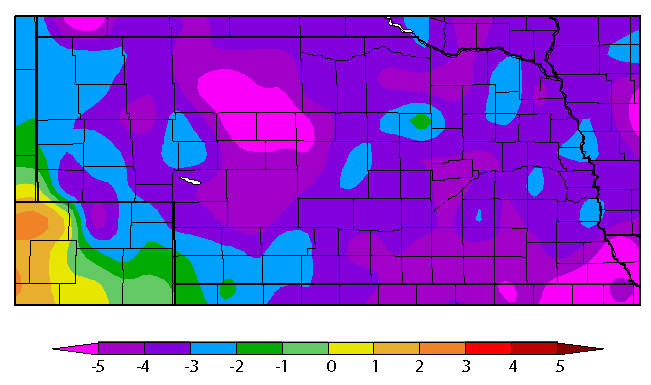With Cooler Week, Corn Maturity Forecasts Move Back
Aug. 26, 2015
Estimated corn maturity dates moved back in today's update. Tables 1-3 estimate the maturity date of corn varieties by location based on normal temperatures for the remainder of the growing season. All locations were calculated for a mid-season variety (105-day maturity). Northern and Panhandle stations were also calculated using a 95-day variety, while southern stations were also calculated using a 115-day variety. Maturity date estimations were calculated based on data through August 24

Average temperatures during the past two weeks were 6-10°F below normal, with the greatest deviations found across the Panhandle and northern Nebraska. Corn maturity estimates have been pushed back by an average of two to three days for areas south of Interstate 80 compared to initial projections released on August 14 using data through August 9. Maturity dates across the Panhandle and northern third of the state were pushed back an average of five to seven days, while the central third of the state had maturity dates pushed back three to five days.
The current two-week outlook indicates normal to above normal temperatures across the state. If this forecast verifies, maturity date estimates should move forward an average of three days statewide, and possibly as much as five days if high temperatures can average in the low 80s during the next two weeks.
Average hard freeze dates in Nebraska are:
- Oct. 1-10 for extreme northern Nebraska and the Panhandle
- October 10-17 for the central third of the state and the southwest
- October 17-24 for extreme southern Nebraska and the southeast corner of the state.
Al Dutcher
State Climatologist
| Table 1. Estimated date of corn maturity based on normal temperature through black layer for a 2450-GDD variety (105-day maturity). | |||
| Date of Emergence | |||
| 5/5 | 5/15 | 5/25 | |
| Ainsworth | 9/26 | 10/1 | 10/7 |
| Beatrice | 9/4 | 9/9 | 9/14 |
| Grand Island | 9/12 | 9/18 | 9/24 |
| Holdrege | 9/13 | 9/18 | 9/28 |
| Indian Cave | 8/30 | 9/4 | 9/10 |
| Lincoln | 9/1 | 9/5 | 9/10 |
| McCook | 9/10 | 9/15 | 9/23 |
| Mitchell | 10/14 | 10/21 | 10/29 |
| Nebraska City | 9/2 | 9/6 | 9/10 |
| Concord | 9/22 | 10/2 | 10/10 |
| North Platte | 9/21 | 9/28 | 10/2 |
| Red Cloud | 9/4 | 9/10 | 9/15 |
| Scottsbluff | 10/7 | 10/14 | 10/22 |
| Table 2. Estimated date of maturity based on normal temperatures through black layer for a 2240-GDD variety (95-day maturity). | |||
| Date of Emergence | |||
| 5/5 | 5/15 | 5/25 | |
| Ainsworth | 9/8 | 9/13 | 9/18 |
| Mitchell | 9/22 | 9/26 | 10/1 |
| Concord | 9/7 | 9/13 | 9/19 |
| North Platte | 9/6 | 9/11 | 9/16 |
| Scottsbluff | 9/18 | 9/22 | 9/26 |
| Table 3. Estimated date of maturity based on normal temperature through black layer for a 2450-GDD variety (115-day maturity). | |||
| Date of Emergence | |||
| 5/5 | 5/15 | 5/25 | |
| Beatrice | 9/19 | 9/28 | 10/4 |
| Grand Island | 10/1 | 10/11 | 10/22 |
| Holdrege | 10/4 | 10/14 | 10/26 |
| Indian Cave | 9/11 | 9/18 | 9/26 |
| Lincoln | 9/16 | 9/20 | 9/28 |
| McCook | 9/29 | 10/6 | 10/16 |
| Nebraska City | 9/14 | 9/21 | 9/30 |
| North Platte | 10/16 | 10/28 | — |
| Red Cloud | 9/20 | 9/28 | 10/7 |
| A "—" signifies that black layer will not be reached before 11/1. | |||
Online Master of Science in Agronomy
With a focus on industry applications and research, the online program is designed with maximum flexibility for today's working professionals.
